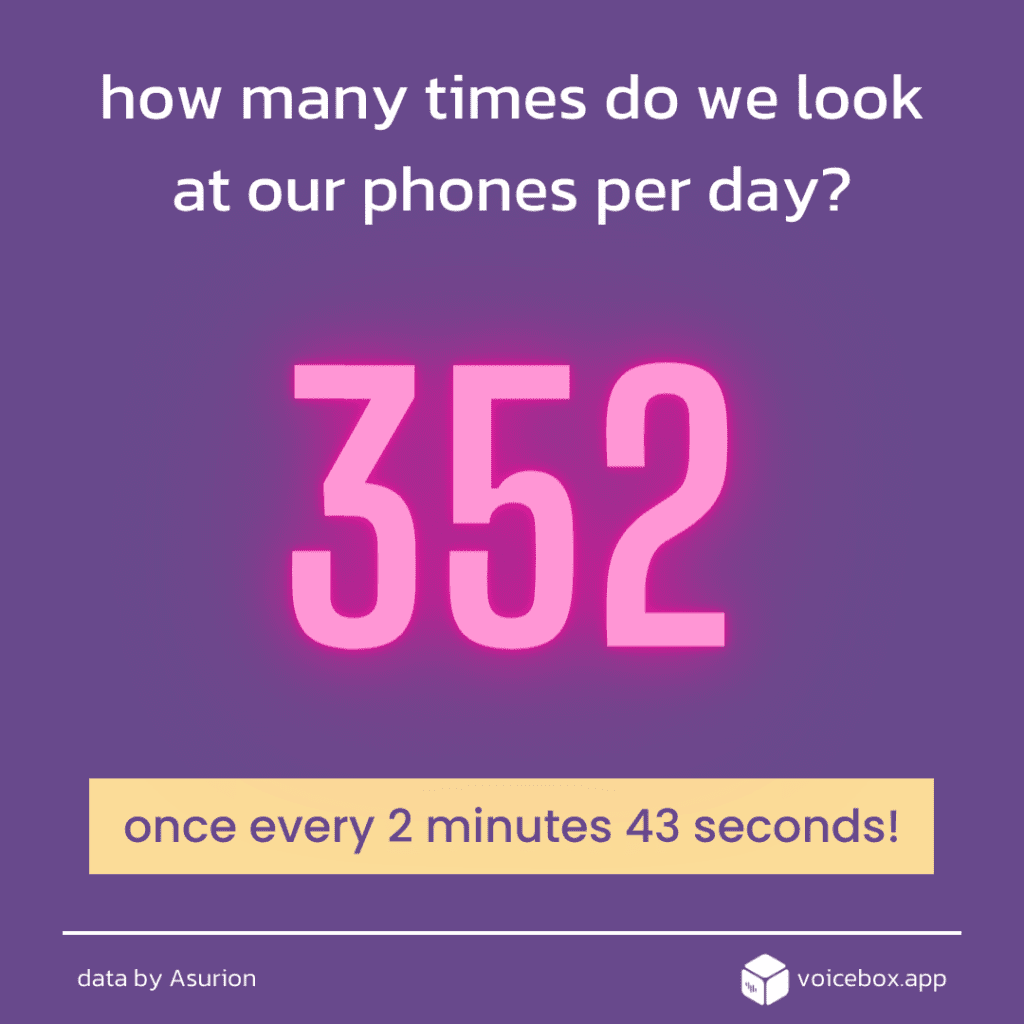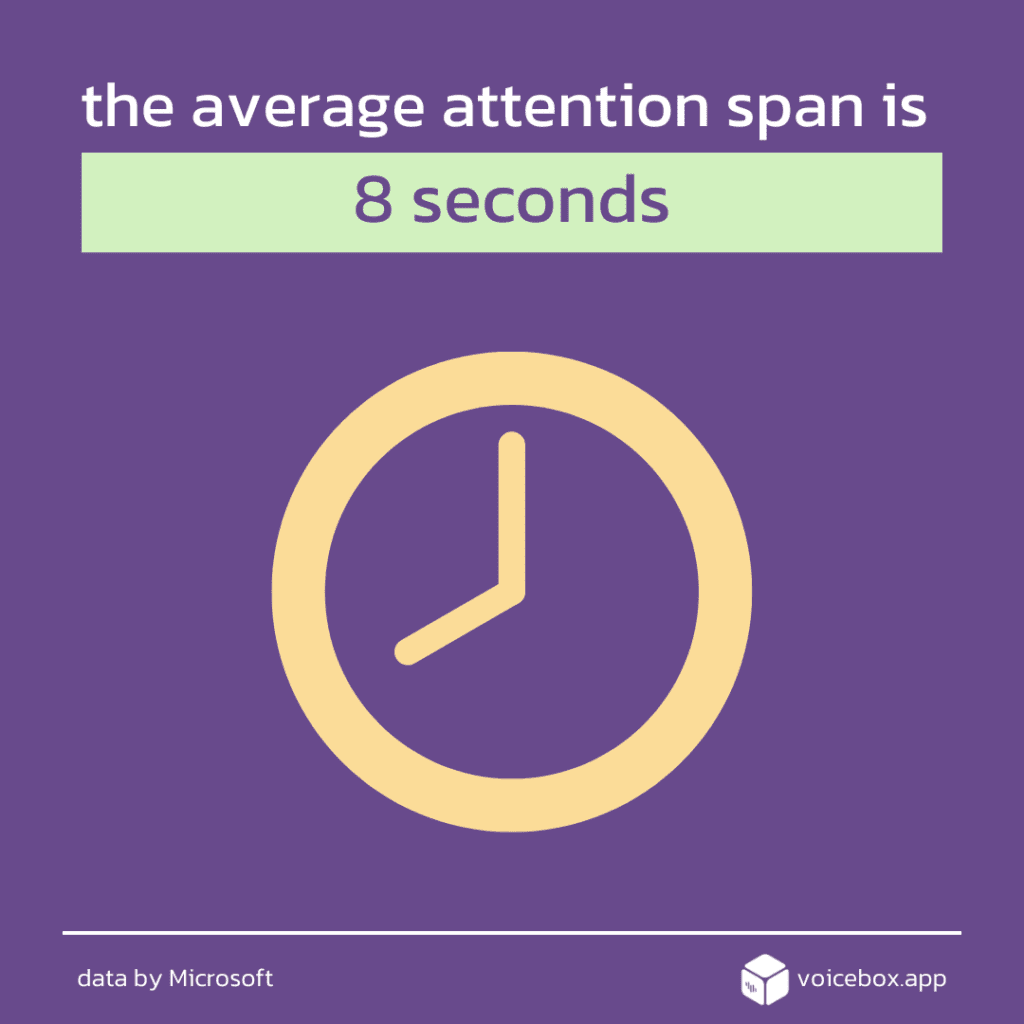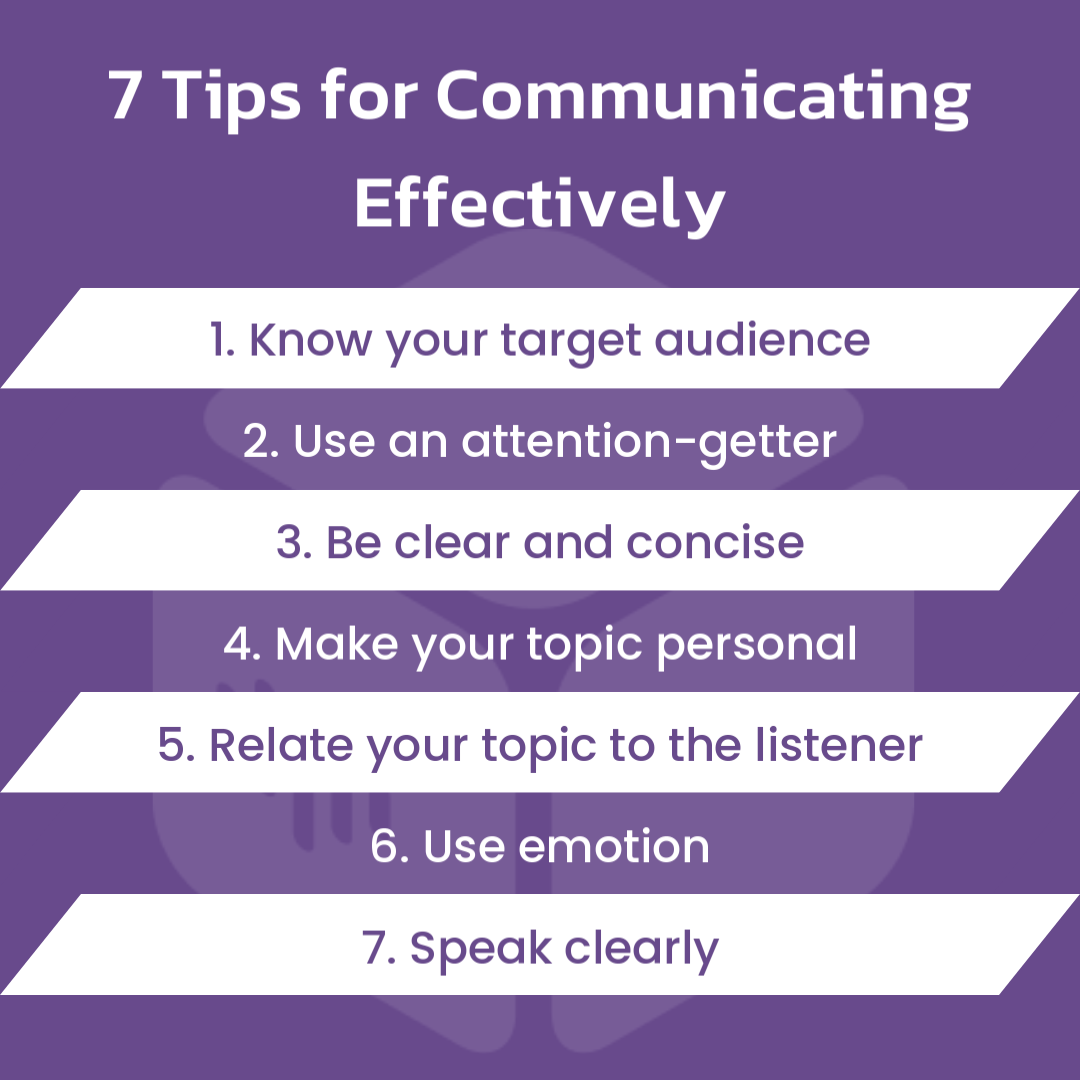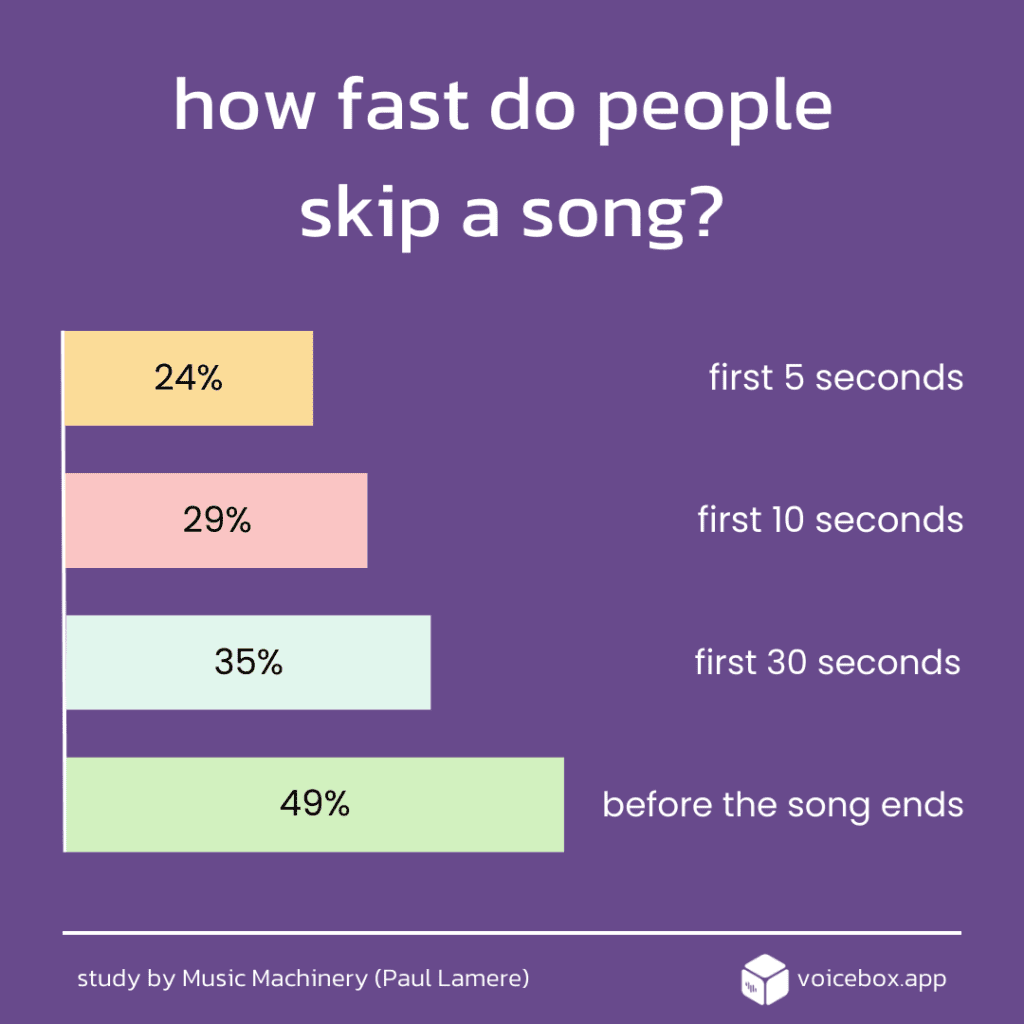Listen to the blog post here.
Ever so often, you’ll find yourself in a position where you need to make your point in a short amount of time. That could be the dreaded elevator pitch at networking events or it could be the even more dreaded sales pitch when cold-calling a potential customer. And don’t think you’re safe if you’re not routinely involved in corporate life. Anything from pick-up lines to explaining yourself to a judge (or your mom) involves needing to choose the most effective but efficient collection of words.
But while all these scenarios seem vastly different from one another, they share the same end goal. You want to wow your listener as quickly as possible. You want to convince them that whatever you’re selling is worth buying. You want to deliver the knockout punch in two minutes or less. In this post, let’s talk about how you can accomplish exactly that.
Short and Sweet
A study by Microsoft found that our attention span nowadays is worse than even that of a goldfish, clocking in at 8 seconds. To illustrate the point, a study by Asurion found that in 2019, people looked at their phones on average 96 times a day. Flash forward 2 years later and that number has skyrocketed to 352. Checking our phones 352 times a day! That’s once every 2 minutes and 43 seconds. It often means while in the middle of a conversation with others, at parties, in class, in meetings, and other times where you would think we should be paying attention.
The point is that just because you think you have someone’s attention, doesn’t mean you really do. And if you do have it, you may not have it for long. So while you have it, you gotta make the most of it.

How to Deliver the Knockout Punch
Each of the following tips is a tried and true method for getting and holding someone’s attention. Depending on your situation, some of these tips will be more or less valuable than others, and I’ll point that out as we go.
Tip 1: Know Your Target Audience
The way you speak to strangers may differ from the way you speak to people you know. And the way you speak to your baby brother differs from the way you speak to your mother (at least I hope). Knowing what your audience likes to hear can help you channel your topic, tone, and word choice so that they can enjoy what they hear.
In the case of a general audience, you might not be able to know what works with every person. In these cases, knowing what doesn't work is just as important. This includes avoiding derogatory/offensive language and cutting out the technical speak (jargon) that others won’t understand.
One final note on knowing the audience: the key word is “target”. Remember that your audience is who you’re trying to speak to, which isn’t always the same as everyone who is present. For example, if you want to speak about a niche topic such as reviewing a TV show, your goal is to speak to the people who either watch that show or may be interested in it. At that point, the general audience may drop out but your goal is to retain your target audience.
Tip 2: Use an Attention-Getter
The attention-getter is a staple in most speeches and presentations. It hooks your audience in such a way that you afford at least more time as you work your way through the rest of your message. I remember in 7th-grade speech class, a student started his speech flailing his arms yelling “Naked people, naked people!” He followed that with “Now that I have your attention.” Of course, this worked wonders with middle schoolers as we all started cracking up, but a completely unrelated intro likely won’t fly depending on the audience (see Tip 1).
Attention-getters come in many forms. No matter the form, the end goal is to get the audience interested in what you’re going to say next.
- Pique the listener’s curiosity by raising a question
- Startle the listener with a noteworthy fact or statistic
- Create a bond between the speaker and listener through a personal anecdote
- Call on a respected authority by quoting a renowned person
- Tell a joke because most people like to listen to someone who makes them laugh
- Make a pop culture reference to establish familiarity
- Use a sound effect, especially if it’s a signature sound that immediately reminds people of something
Even in a short spiel, like say a couple of minutes, an attention-getter can be the difference between someone listening the whole way or skipping. Consider short-form video apps. Very often, the creator will put text on the screen so you can immediately know what’s going on. This is an effective way to grab people’s attention.
In the case of listening to recordings, this might be doable with captions and images, but what if the listener isn’t looking at their phone? When the onus is on your words to grab someone’s attention, the examples play a critical role. And knowing your audience goes a long way in knowing what will work best in grabbing their attention.
Tip 3: Be Clear and Concise
In the words of the immortal Kevin Malone from The Office, “Why waste time say lot word when few word do trick?” Kevin botches the execution of this idea, but there is merit to the principle. We’re busy people. Wasting your listener’s time with fluff can not only confuse them, but it can also get them to outright stop listening. And when you only have a little time to communicate your message, clarity and brevity are the name of the game.
Arguably the most important facet of being clear and concise is to state your point. In school and higher academia, we’re often taught to put our thesis in the opening paragraph of a paper, before the meat of our argument. The reasons for this are because:
- It acts as an attention-getter
- It tells the reader exactly what to expect
- It serves as the anchor that ties the rest of the paper together
This same logic applies to short talks. No one likes a speaker who wastes their time by beating around the bush (circumnavigates the main point). Think of the sitcom where the teenager wants a raise in their allowance and tries sweet talking their parent, only for the parent to sternly respond, “Get to the point”.
You don’t want to frustrate your listener with shenanigans. It may even be advantageous to make your point right away because whether it’s something relatable or something the listener completely disagrees with, they’ll now be hooked to see where you’re going with it.

Tip 4: Make Your Topic Personal
Back when I competed in oratory in high-school debate, people spoke on all sorts of topics, from reverse racism to eating insects. Despite those differences, one of the most common practices between all the speeches was personal anecdotes. This works on several levels:
- It humanizes you and makes you more relatable. Getting people to connect with you on an emotional level is perhaps the most surefire way to maintain their attention.
- It makes your point more memorable. If I tell you something, it might stick, but using an example from my own history can make the argument far more compelling. Consider the “naked people” example above.
- It allows the listener to visualize your words. People relate to stories, and as mentioned in the Listening Tips post, picturing what is being said helps a listener to understand the message. So make their job easier by painting a picture.
Another reason why this is so important is because it ties you to the topic. People listen to authority. If Gordon Ramsay gives you a cooking lesson, you listen. If I give you a cooking lesson, you run away knowing a fire likely starts in the kitchen. Making your message personal allows people to acknowledge you as a reliable source. People are far more likely to listen to that.
Tip 5: Relate Your Topic to the Listener
This is the inverse of the previous point, though oftentimes they go hand in hand. Most people do things to gain some benefit, whether that be monetary (working), physical (exercise), mental (mediation), etc. So providing your listener with some sort of benefit for listening will help you maintain their attention.
The benefits of listening range all over the place, such as learning something new, entertainment, or connecting with the speaker's emotions. When you relate your words back to your listener, you let them know that they're not alone. People love that. It answers the question of “what’s in it for me”.
The question then is, how do you relate what you’re saying back to the listener? Some topics lend themselves to this point. For example, if you talk about a public policy matter, such as taxes, most people automatically have a stake in it. Another direct way to relate to your listener is to involve them. You can do this through techniques such as posing a question that gets them to think about the topic from their own lens.
Keep in mind that the link between your words and your listener doesn’t have to be established directly. If I talk about my experience losing in the finals of a gaming competition, a listener may relate by thinking of a time when they competed and lost, or otherwise failed to meet their own expectations. So much of how we relate to one another is not based on the specific happenings, but on the emotions we feel. Those connect us on a human level.
Tip 6: Use Emotion
Extending on the previous point, emotion drives so much of what we say, do, and listen to. The modern-day political rally is a prime example of this, where the talking points inspire or rile up people as opposed to discussing the substance of the issues. This isn’t a matter of right or wrong, just an example of what works. Speaking to people’s emotions works.
In order to speak to people’s emotions, you yourself need to use emotions. Imagine that same political rally, where the politician tries to get a chant going with a monotone voice. It wouldn’t work. If people don’t hear the inspiration, the anger, the sadness, the happiness in your voice, they won’t feel it either.
As cognitive neuroscientist Dr. Lynda Shaw writes, “Emotional expressions are necessary to enhance messages, to convey authenticity, and to develop trust.” Speaking with passion not only convinces the listener that you care about your subject, but it establishes that heart-to-heart connection. By now you understand how strongly I feel about connecting emotionally with others considering I’ve spent the last 3 tips talking about it.
Tip 7: Speak Clearly
This last tip is a bit of a no-brainer, but I would be remiss to not include it. The last thing you want to do is spend time crafting the perfect message with a great personal anecdote, pinpoint emotion, and a fantastic attention-getter, only to throw it all away because no one can understand you.
The Podcast Host found that 51% of people will stop listening if the sound quality isn’t similar to “pro Radio” (eg. BBC, NPR). While people may be more forgiving in a setting like Voicebox where amateur quality is more of the norm, you should still do your best to speak at a proper speed and volume, enunciate, and cut out external noise as much as possible. Don’t trip yourself up over the basics!
As mentioned above, the degree to which these tips apply largely depends on your goal, your topic, your words, and more. There may be times when you don’t need to make your point right away, leverage emotion, relate it back to the listener, or any of these other things. Determine what works best for you and your audience, then apply these tips accordingly.

For All You Listeners Out There
Communication is a two-way street. While communicating effectively has a lot to do with how the message is delivered, it hardly means a thing if the recipient isn’t listening effectively. The onus is on both parties to make sure the lines of communication are taut. For more on this, check out my post on effective listening here.
Holding Folks’ Attention on Voicebox
The ability to hold someone’s attention when there’s so much happening around them is truly a masterful skill. In the case of Voicebox, this skill holds extreme relevance due to the nature of social apps. People are accustomed to quickly swiping onto the next piece of content on visual-based social media. While audio-based content can’t be judged by looking at it, a few seconds into the sound can be enough for a listener to decide if they want to keep listening or skip.
To provide a relatable example, a study by Music Machinery found that 24% of people skip a song in the first 5 seconds. That number climbs up all the way to nearly half of people (49%) skipping a song before it ends.

Songs and voice notes certainly aren’t exact substitutes. Music is typically a more emotional experience, and listening habits are likely to be influenced by pre-established tastes. But this study does provide some valuable insight into listening patterns in general.
So whether you’re talking about your day, giving a piece of advice, or even singing a song, remember that the attention you hold in the voiceboxing ring may not last. Use the tips above to hook and jab your listener on the way to delivering that knockout punch!
Sunday Blog is a series where we discuss the many facets and functions of the human voice.

